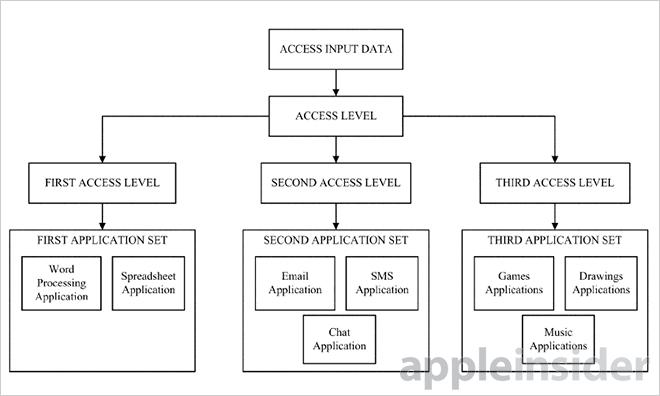A future version of iOS may feature a unique security method that recognizes different gesture inputs to open specific sets of apps, allowing for greater control over user access.

Source: USPTO
The technology, detailed in a patent awarded to Apple on Tuesday by the U.S. Patent and Trademark Office, deals with so-called "access inputs" that determine what apps, device services and functions can be accessed by a user.
Apple's U.S. Patent No. 8,528,072 for a "Method, apparatus and system for access mode control of a device," describes a system that creates user access modes guarded by predetermined gesture inputs.
Currently, Apple's iOS offers passcode unlocking as a means of access control. Under this method, users must input a simple code or password to gain complete access to the device. Apple also provides a certain level of user configuration, allowing access to Siri, Passbook and Reply with Message even when a device is locked.
The newly patented method would enhance or replace the existing passcode protocol with a gesture-based means of toggling access modes from locked to a variety of unlocked states. For example, a first gesture may be used to access gaming functions, while keeping email and contacts information locked. A subsequent second gesture may then grant access to an email or contacts app without any further interaction from the user.
As noted in the document, any number of gestures can be applied to the system, including the drawing of shapes, letters and patterns. Some embodiments call for a user to draw a circle, then a letter, to open a specific app or access a certain function. For example, to open an email app, a user could draw a circle followed by the letter "A."
Gestures can be arranged by category, like "gaming apps" or "communications," allowing for a more flexible unlocking routine. This partial unlocking allows access only to those apps associated with an unlocked category.
Illustration of access module.
Along with the usual touchscreen inputs, keyboard, mouse or stylus events can also be used to trigger access modes. In one embodiment, a user's voice becomes the "gesture" which opens a particular app or set of apps.
In some cases, more than two levels or modes of access can be configured. A user may preview a list of SMS texts or emails, which requires a first level of access. To respond, a second gesture is needed to open the communications app. Finally, a third level of access can be reached when switching away to a different category of apps or functions.
The patent notes that this stepped process can be configured to grant total access at any one level, making the system more usable on a day-to-day basis.
Aside from the obvious security applications, iOS device owners may apply the tech to manage access when lending a handset to a friend or child. Such a method may, for example, be used to prohibit in-app purchases by allowing children to play a game with a first gesture, but requiring a second secret input for App Store access.
Apple's access mode patent was first filed for in 2010 and credits Jianxiong Jason Shi as its inventor.


